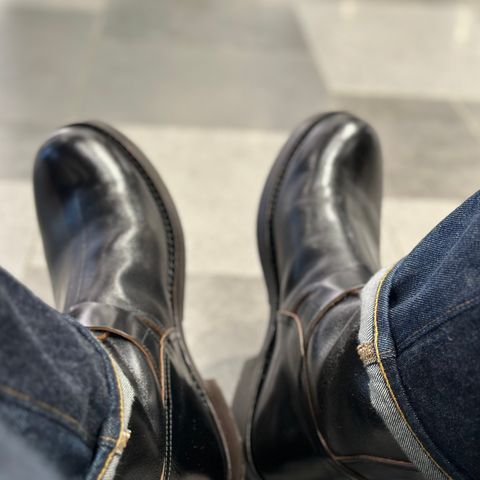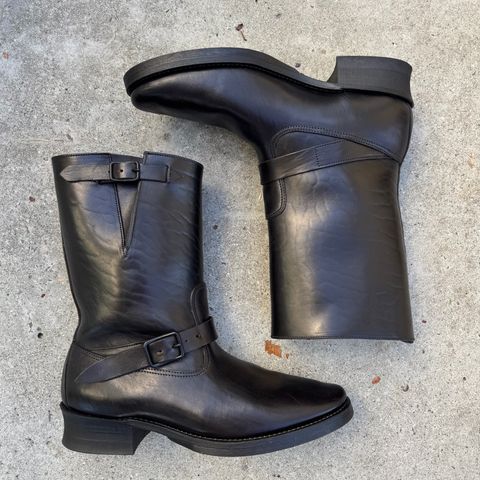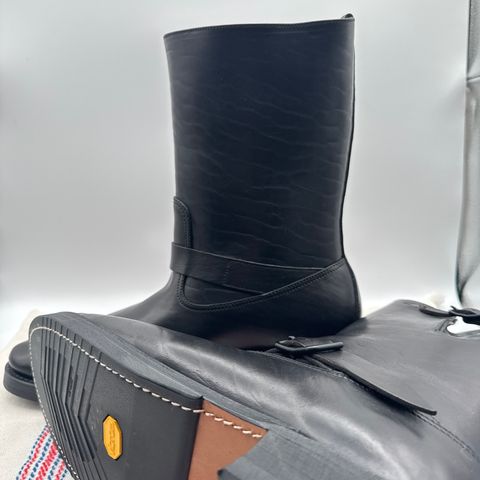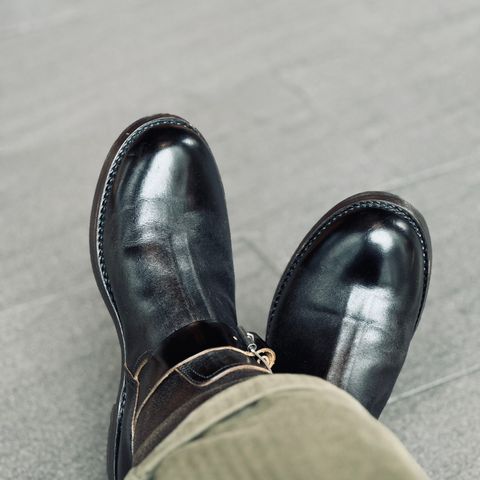About
Shinki Black Latigo Horsehide is a vegetable-tanned horsehide leather produced by Shinki Hikaku, the only tannery globally to specialize exclusively in horse leather. This extra heavyweight Shinki Latigo Horsehide variant features a black drum-dyed finish with an oil and wax coating that creates a glossy surface which dulls over time with wear. The leather undergoes a four-month production cycle at Shinki's facility in Himeji, Japan, involving mimosa bark vegetable tanning, pit tanning, and natural air drying stages. At 1.2 to 1.3 millimeters thick, Black Latigo Horsehide develops distinctive character through wear, with fully shrunken grains creating ripples over time as the leather molds to its owner's use patterns.
About
Shinki Black Latigo Horsehide is a vegetable-tanned horsehide leather produced by Shinki Hikaku, the only tannery globally to specialize exclusively in horse leather. This extra heavyweight Shinki Latigo Horsehide variant features a black drum-dyed finish with an oil and wax coating that creates a glossy surface which dulls over time with wear. The leather undergoes a four-month production cycle at Shinki's facility in Himeji, Japan, involving mimosa bark vegetable tanning, pit tanning, and natural air drying stages. At 1.2 to 1.3 millimeters thick, Black Latigo Horsehide develops distinctive character through wear, with fully shrunken grains creating ripples over time as the leather molds to its owner's use patterns.
Manufacturing process
The production of Black Latigo Horsehide begins with Shinki Hikaku's vegetable tanning process using mimosa bark imported from Australia. Raw horse hides are pit tanned at the tannery's facility in Himeji, Japan, where they undergo months-long soaking in tanning liquor. This vegetable tanning method differs from traditional latigo leather, which is typically combination tanned using chrome tanning followed by vegetable tanning. Shinki's approach maintains the leather as fully vegetable tanned throughout the entire process.
Following the initial tanning stages, the hides undergo natural air drying and aging that contributes to the leather's unique texture and grain characteristics. The full production cycle from raw hide to finished leather takes up to four months, with extended drying periods allowing the leather structure to stabilize and develop its distinctive properties.
After tanning and drying are complete, the leather is drum dyed black on black, creating a consistent base color throughout the hide. This double black dyeing ensures the leather maintains its black appearance throughout its lifespan. The hides then receive a light pigment finish followed by a coating of oils and waxes. This finishing treatment creates the characteristic glossy top coat and adds weight to the leather beyond its natural thickness.
The leather is split and shaved to a final thickness between 1.2 and 1.3 millimeters, equivalent to 2.5 to 2.75 ounces. This specification makes it suitable for applications requiring substantial durability while maintaining workability for construction of boots, jackets, and leather goods.
Characteristics
Black Latigo Horsehide features a full grain surface with an uncorrected finish, allowing the natural characteristics of the horsehide to remain visible. The leather can exhibit either smooth or grainy texture depending on the original hide properties, with variations in grain structure contributing to each piece's individual character. The distinctive smell associated with Shinki's mimosa tanning process remains detectable in the finished leather.
The extra heavyweight nature of the leather creates low flexibility compared to lighter horsehides, making it particularly suitable for applications requiring structural support such as belts, straps, and boot construction. The oil and wax coating adds additional weight beyond the leather's natural density, contributing to a heavier feel in hand compared to uncoated horsehides of similar thickness.
The glossy surface created by the oil and wax finish provides initial water resistance and visual appeal. This coating is not permanent, as the glossy appearance gradually dulls to a more matte finish through regular wear and exposure. The black underdye maintains consistent color throughout the leather's thickness, preventing the base leather color from showing through even as the surface coating wears away over extended periods.
The leather's unique intricacies and character stem from Shinki Hikaku's specialized production methods and exclusive focus on horse leather. These characteristics distinguish Black Latigo Horsehide from other black leathers and make each hide difficult to procure due to the tannery's small scale and limited production capacity.
Teacore variant
A teacore variant of Black Latigo Horsehide features a brown inner layer beneath the black exterior surface. This construction method involves dyeing the base leather brown before applying the black surface dye, creating a deliberate color contrast that emerges through wear and use.
As the black outer layer experiences abrasion, flexing, and exposure, it gradually chips and fades to reveal the underlying brown leather. This transformation is visible first at edges and high-wear areas where the surface coating wears through most quickly. The revealed brown tones give teacore leather its distinctive name and visual character.
The brown undertone becomes visible at raw edges even on new leather, providing an early indication of the patina that will develop over time. This teacore construction represents a traditional approach to durable leather finishing, where the aging process is embraced as a desirable characteristic rather than a defect to be prevented.
The gradual color transformation occurs naturally through regular use, with each item developing a unique pattern based on individual wear patterns, handling frequency, and environmental exposure. Areas subject to repeated flexing show brown tones emerging first, while protected surfaces maintain the black appearance longer, creating organic color variations across the leather surface.
Patina development
Black Latigo Horsehide develops character through mechanical and environmental factors during use. The fully shrunken grains within the leather structure respond to stress and movement by popping up to create ripples across the surface. This grain animation becomes more pronounced as the leather ages, adding visual texture that was not present in the unworn state.
Exposure to moisture accelerates character development in the leather. When the leather gets wet, the fibers swell and then contract as they dry, accentuating the grain patterns and creating more defined texture. Repeated wetting and drying cycles compound this effect, progressively enhancing the leather's surface character.
The leather molds to conform to the wearer's body shape and movement patterns over time. Areas subject to consistent pressure or flexing develop distinct creasing and shape memory, causing the leather to become increasingly personalized to its owner's specific usage. This molding process is irreversible, permanently recording the history of wear in the leather's structure.
For teacore variants, the patina includes the color transformation as brown tones emerge through the black surface. The rate and pattern of this color change varies based on usage intensity, with heavily worn areas showing more brown exposure than lightly used sections. Sunfading contributes to surface color changes, working in combination with mechanical wear to accelerate the teacore effect.
The oil and wax coating gradually diminishes from the surface through handling and environmental exposure. As this protective layer wears away, the underlying leather becomes more exposed to direct contact, potentially affecting the rate of subsequent aging. The leather continues to develop character throughout its functional lifespan, becoming increasingly distinct as the years accumulate.
Applications
Black Latigo Horsehide serves in applications requiring durable leather with substantial weight and structure. The extra heavyweight nature and low flexibility make the leather particularly suitable for service boots, where structural integrity and long-term durability are prioritized over softness. Boot manufacturers utilize the leather for its ability to maintain shape under stress while developing character through wear.
Leather jacket production represents another primary application for this horsehide. The 1.2 to 1.3 millimeter thickness provides adequate protection and wind resistance while remaining light enough for outerwear construction. The leather's ability to mold to the wearer's body makes it well-suited for jackets that improve in fit and comfort over time.
Belts and straps benefit from the leather's low flexibility and robust construction. The extra heavyweight specification prevents stretching under load, while the oil and wax treatment provides initial moisture resistance. These characteristics align with traditional latigo leather applications, though the horsehide composition provides different aging properties compared to cattle hide latigo.
High-end leather goods manufacturers select Black Latigo Horsehide for products where distinctive aging characteristics and premium materials justify the leather's limited availability and higher cost. The unique character of Shinki's production and the teacore variant's color transformation appeal to customers seeking leather goods that develop individual personality through use.
The leather's scarcity due to Shinki Hikaku's specialized production and small scale limits its availability in the market. This restricted supply affects which manufacturers can source the material, with established relationships with the tannery often necessary to secure consistent access to the leather.
References
"Service Boot Horsehide Latigo". Viberg Journal. Retrieved October 11, 2025.
"Learn About Our Leather". Himel Bros. Retrieved October 11, 2025.
"Latigo leather". Wikipedia. Retrieved October 11, 2025.







































































